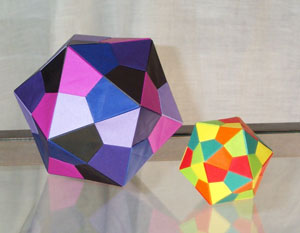The regular icosahedron, often simply called "the" icosahedron, is the regular polyhedron and Platonic
solid illustrated above having 12 polyhedron
vertices, 30 polyhedron edges, and 20 equivalent
equilateral triangle faces, . It is illustrated above together with a wireframe version
and a net that can be used for its construction.
The regular icosahedron is also the uniform polyhedron with Maeder index 22 (Maeder 1997), Wenninger index 4 (Wenninger 1989), Coxeter index
25 (Coxeter et al. 1954), and Har'El index 27 (Har'El 1993). It is described
by the Schläfli symbol and Wythoff symbol
. Coxeter et al. (1999) have
shown that there are 58 icosahedron stellations
(giving a total of 59 solids when the icosahedron itself is included).
A number of symmetric projections of the regular icosahedron are illustrated above.
The regular icosahedron is implemented in the Wolfram Language as Icosahedron[] or UniformPolyhedron["Icosahedron"], and precomputed properties are available as PolyhedronData["Icosahedron"].

Two icosahedra constructed in origami are illustrated above (Gurkewitz and Arnstein 1995, p. 53). This construction uses 30 triangle edge modules, each made from a single sheet of origami paper.
Two icosahedra appears as polyhedral "stars" in M. C. Escher's 1948 wood engraving "Stars" (Forty 2003, Plate 43).
There are 43380 distinct nets for the icosahedron, the same number as for the dodecahedron (Bouzette and Vandamme, Hippenmeyer 1979, Buekenhout and Parker 1998).
The icosahedron has the icosahedral group of symmetries. The connectivity of
the vertices is given by the icosahedral graph.
The regular icosahedron is the convex hull of the first and second dodecahedron stellations, great dodecahedron great icosahedron, 11th icosahedron stellation, and small stellated dodecahedron.
|
|
|
The dual polyhedron of an icosahedron with unit edge lengths is the dodecahedron with edge lengths
,
where
is the golden ratio. As a result, the centers of
the faces of an icosahedron form a dodecahedron,
and vice versa, illustrated above (Steinhaus 1999, pp. 199-201).
In particular, fifteen golden rectangles span the interior of the icosahedron. These rectangles have 30 edges, and each edge pairs up with its opposite edge to form a golden rectangle
There are 59 distinct icosahedra when each triangle is colored differently (Coxeter 1969). More general question of polyhedron coloring can be addressed using the Pólya enumeration theorem.
Taken eight at a time, the centers of the faces of an icosahedron comprise the vertices of a cube. This leads to the beautiful cube 5-compound and is the basis for Jessen's orthogonal icosahedron.
A plane perpendicular to a axis of an icosahedron cuts the solid in a regular decagonal cross section (Holden 1991, pp. 24-25).
The long diagonals of the faces of the rhombic triacontahedron give the edges of an icosahedron (Steinhaus 1999, pp. 209-210).
The following table gives polyhedra which can be constructed by augmentation of an icosahedron by pyramids of given heights .
| result | ||
| great dodecahedron | ||
| small triambic icosahedron | ||
| 60-faced star deltahedron | ||
| 3 | great stellated dodecahedron |
A construction for an icosahedron with side length places the end vertices at
) and the central vertices around two staggered circles of radii
and heights
. By a suitable rotation, the polyhedron
vertices of an icosahedron of side length 2 can also be placed at
,
, and
, where
is the golden ratio. These
points divide the polyhedron edges of an octahedron
into segments with lengths in the ratio
. Another orientation of the icosahedron places two opposite
triangular faces in an orientation parallel to the
-plane. In this orientation, the distance
from the top plane to the triangle
of vertices below it is
, equal to the circumradius of a face. The circumradius
of
is given by
|
(1)
|
To derive the volume of an icosahedron having edge length ,
consider the orientation so that two polyhedron
vertices are oriented on top and bottom. The vertical distance between the top
and bottom pentagonal dipyramids is then
given by
|
(2)
|
where
|
(3)
|
is the height of an equilateral triangle, and the sagitta of the pentagon is
|
(4)
|
giving
|
(5)
|
Plugging (3) and (5) into (2) gives
|
(6)
|
which is identical to the radius of a pentagon of side .
The circumradius is then
|
(7)
|
where
|
(8)
|
is the height of a pentagonal dipyramid. Therefore,
|
(9)
| |||
|
(10)
|
Taking the square root gives the circumradius
|
(11)
| |||
|
(12)
| |||
|
(13)
|
The inradius is
|
(14)
|
The square of the midradius is
|
(15)
|
so
|
(16)
|
The dihedral angle is
|
(17)
|
and the Dehn invariant of a regular icosahedron is
|
(18)
| |||
 |
(19)
| ||
|
(20)
|
(OEIS A377698), where the first expression uses the basis of Conway et al. (1999).
The area of one face is the area of an equilateral triangle
|
(21)
|
The volume can be computed by taking 20 pyramids of height
|
(22)
|
Apollonius showed that for an icosahedron and a dodecahedron with the same inradius,
|
(23)
|
where
is the volume and
the surface area, with the actual ratio being
|
(24)
|
